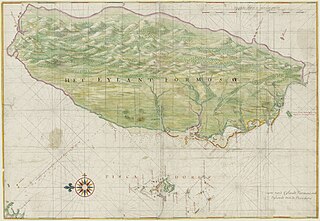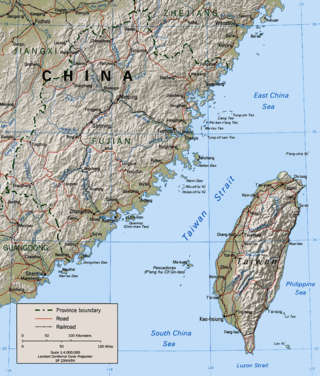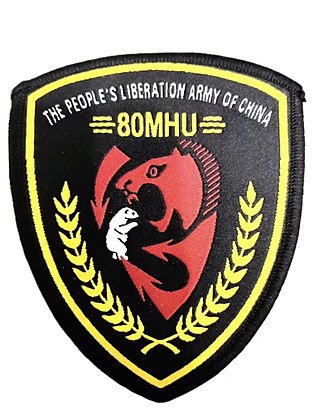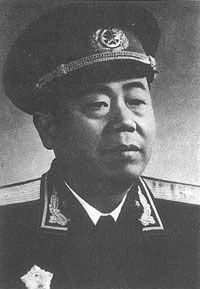
The Republic of China Armed Forces are the armed forces of the Republic of China (ROC) that once ruled Mainland China and now currently restricted to its territorial jurisdictions of Taiwan, Penghu, Kinmen and Matsu Islands. They consist of the Army, Navy, Air Force and Military Police Force. The military is under the civilian control of the Ministry of National Defense, a cabinet-level agency overseen by the Legislative Yuan.

As a result of the surrender and occupation of Japan at the end of World War II, the islands of Taiwan and Penghu were placed under the governance of the Republic of China (ROC), ruled by the Kuomintang (KMT), on 25 October 1945. Following the February 28 massacre in 1947, martial law was declared in 1949 by the Governor of Taiwan, Chen Cheng, and the ROC Ministry of National Defense. Following the end of the Chinese Civil War in 1949, the ROC government retreated from the mainland as the Chinese Communist Party (CCP) proclaimed the establishment of the People's Republic of China. The KMT retreated to Taiwan and declared Taipei the temporary capital of the ROC. For many years, the ROC and PRC each continued to claim in the diplomatic arena to be the sole legitimate government of "China". In 1971, the United Nations expelled the ROC and replaced it with the PRC.

The First Taiwan Strait Crisis was a brief armed conflict between the People's Republic of China (PRC) and the Republic of China (ROC) in Taiwan. The conflict focused on several groups of islands in the Taiwan Strait that were held by the ROC but were located only a few miles from mainland China.

The Second Taiwan Strait Crisis, also called the 1958 Taiwan Strait Crisis, was a conflict between the People's Republic of China (PRC) and the Republic of China (ROC). In this conflict, the PRC shelled the islands of Kinmen (Quemoy) and the Matsu Islands along the east coast of mainland China in an attempt to take control of Taiwan from the Chinese Nationalist Party, also known as the Kuomintang (KMT), and to probe the extent of the United States' defense of Taiwan's territory. A naval battle also took place around Dongding Island when the ROC Navy repelled an attempted amphibious landing by the PRC Navy.

The Battle of Kuningtou or Battle of Guningtou (Chinese: 古寧頭之役; pinyin: Gǔníngtóu zhī yì; Wade–Giles: Ku3-ning2-t’ou2 chih1 i4), also known as the Battle of Kinmen (金門戰役; Jīnmén Zhànyì), was fought over Kinmen in the Taiwan Strait during the Chinese Civil War in 1949. The failure of the Communists to take the island left it in the hands of the Kuomintang (Nationalists) and crushed their chances of taking Taiwan to destroy the Nationalists completely in the war.
The Dachen Islands, Tachen Islands or Tachens are a group of islands off the coast of Taizhou, Zhejiang, China, in the East China Sea. They are administered by the Jiaojiang District of Taizhou. Before the First Taiwan Strait Crisis in 1955, the islands were administered by the Republic of China (ROC).

The Republic of China Army (ROCA), also known as the ROC Army and unofficially as the Taiwanese Army, is the largest branch of the Republic of China Armed Forces. An estimated 80% of the ROC Army is located on Taiwan, while the remainder are stationed on the Penghu, Kinmen, Matsu, Dongsha and Taiping Islands.

The Republic of China Marine Corps is the amphibious arm of the Republic of China Navy (ROCN) responsible for amphibious warfare, counter-landing and reinforcement of the areas under the jurisdiction of the Republic of China (ROC), including the island of Taiwan, Kinmen, and the Matsu Islands, and defense of ROCN facilities, also functioning as a rapid reaction force and a strategic reserve capable of amphibious assaults.

The Regimental Combat Team 31 (RCT-31), commonly referred to as Task Force Faith of the "Chosin Few", is a United States Army unit known for its role in the Battle of Chosin Reservoir during the Korean War where 90-95% of its force was killed, wounded, and/or captured on the eastern side of the reservoir.
The Yijiangshan Islands are two small islands 13 kilometres (8.1 mi) from the Dachen Islands, located off the coast of Taizhou, Zhejiang, in the East China Sea.
The Battle of Nanri Island was a conflict between the Republic of China Army (ROCA) and the People's Liberation Army (PLA), over Nanri Island in today's Nanri Town, Xiuyu District, Putian, Fujian, People's Republic of China off the coast of Mainland China. This conflict occurred from 11 October 1952, to 15 October 1952, and resulted in a ROCA victory with complete destruction of PLA forces. However ROCA later abandoned this island and retreated, with all its captured prizes and POWs, to Taiwan.

The Battle of Vyborg Bay was fought in the Finnish-Soviet Continuation War (1941–1944).

The 80th Medium Combined Arms Brigade, formerly the 80th Division, is a military formation of the People's Liberation Army Ground Force. It's now a maneuver part of the PLA 82nd Group Army.

The Battle of Dachen Archipelago was a struggle between the Nationalists and the Communists for the control of several archipelagos just off the coast of Zhejiang, China, during the Chinese Civil War in the post-World War II era, and it was part of the First Taiwan Strait Crisis. The PLA targeted and eventually took the Dachen Archipelago, and the other two smaller archipelagos from Nationalists: the Southern Muntjac Archipelago and the Southern Deer Mountain Archipelago.
The Battle of Hainan Island occurred in 1950, during the final phase of the Chinese Civil War. The People's Republic of China (PRC) conducted an amphibious assault on Hainan Island on 16 April, assisted by the Hainan communist movement which controlled much of the island's interior, while the Republic of China (ROC) controlled the coast; their forces were concentrated in the north near Haikou and were forced to retreat south after the landings. The communists secured Hainan's southern cities by the end of the month and declared victory on 1 May.

Zhejiang or Chekiang is a de jure province in the Republic of China according to the ROC law, as the ROC government formally claims to be the legitimate government of the whole China. Founded after the collapse of the Qing dynasty, it was de facto abolished after the ROC armed forces, ROC government officials and local residents were evacuated from Dachen to Taiwan in 1955 following the military defeat of the ROC by People's Liberation Army forces of the newly-founded People's Republic of China during the Battle of Dachen Archipelago.

The territory of the People's Republic of China (PRC) has frequently been revised since its formation on 1 October 1949.

Nie Fengzhi was a general of the People's Liberation Army Air Force (PLAAF) of the People's Republic of China.

The Operation King Kong was a joint military operation of the United States Navy and the Republic of China Armed Forces that started on the 8th February, 1955. The objective was to withdraw soldiers, people and military equipment and supplies from the Dachen Islands, Pishan Island and Yushan Island to Taiwan.
Phase III of the Tet offensive of 1968 was launched by the People's Army of Vietnam (PAVN) and Viet Cong (VC) from 17 August to 27 September 1968. The offensive was divided into two waves of attacks from 17 to 31 August 1968 and from 11 to 27 September of that same year.














